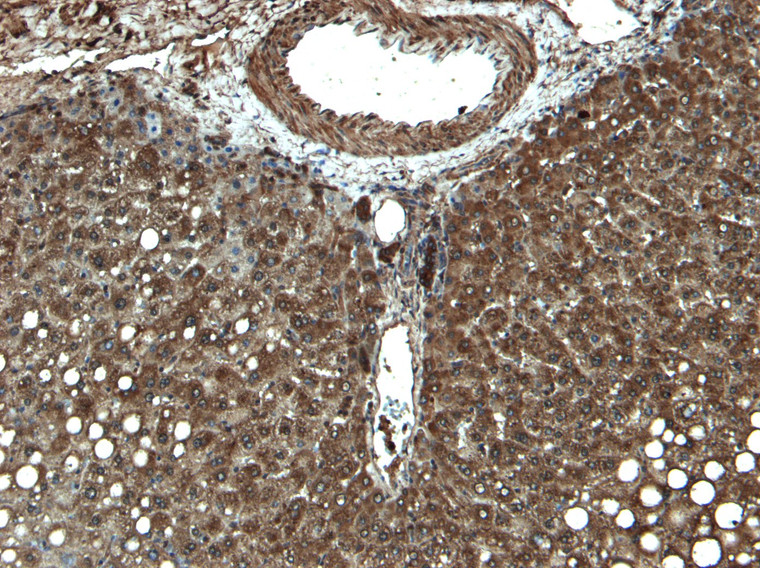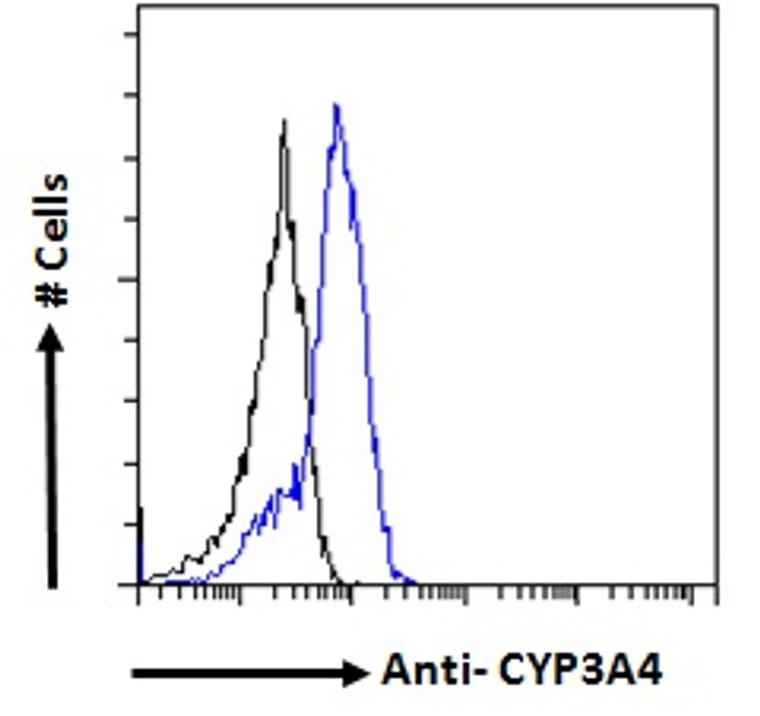| Host: |
Goat |
| Applications: |
Pep-ELISA/IHC/FC |
| Reactivity: |
Human |
| Note: |
STRICTLY FOR FURTHER SCIENTIFIC RESEARCH USE ONLY (RUO). MUST NOT TO BE USED IN DIAGNOSTIC OR THERAPEUTIC APPLICATIONS. |
| Short Description: |
Goat polyclonal antibody anti-CYP3A4 (Internal) is suitable for use in ELISA, Immunohistochemistry and Flow Cytometry research applications. |
| Clonality: |
Polyclonal |
| Conjugation: |
Unconjugated |
| Isotype: |
IgG |
| Formulation: |
0.5 mg/ml in Tris saline, 0.02% sodium azide, pH7.3 with 0.5% bovine serum albumin. NA |
| Purification: |
Purified from goat serum by ammonium sulphate precipitation followed by antigen affinity chromatography using the immunizing peptide. |
| Concentration: |
0.5 mg/mL |
| Dilution Range: |
IHC-5-7µg/mlFC-Flow cytometric analysis of HepG2 cells. 10ug/mlELISA-antibody detection limit dilution 1:8000. |
| Storage Instruction: |
Store at-20°C on receipt and minimise freeze-thaw cycles. |
| Gene Symbol: |
CYP3A4 |
| Gene ID: |
1576 |
| Uniprot ID: |
CP3A4_HUMAN |
| Immunogen Region: |
Internal |
| Accession Number: |
NP_059488.2; NP_001189784.1 |
| Specificity: |
This antibody is expected to recognise both reported isoforms (NP_059488.2; NP_001189784.1) and it is not expected to cross-react with 3A5, 3A7 ot 3A43. |
| Immunogen Sequence: |
KESRLEDTQKHR |
| Post Translational Modifications | Polyubiquitinated in the presence of AMFR and UBE2G1 and also STUB1/CHIP and UBE2D1 (in vitro). |
| Function | A cytochrome P450 monooxygenase involved in the metabolism of sterols, steroid hormones, retinoids and fatty acids. Mechanistically, uses molecular oxygen inserting one oxygen atom into a substrate, and reducing the second into a water molecule, with two electrons provided by NADPH via cytochrome P450 reductase (NADPH--hemoprotein reductase). Catalyzes the hydroxylation of carbon-hydrogen bonds. Exhibits high catalytic activity for the formation of hydroxyestrogens from estrone (E1) and 17beta-estradiol (E2), namely 2-hydroxy E1 and E2, as well as D-ring hydroxylated E1 and E2 at the C-16 position. Plays a role in the metabolism of androgens, particularly in oxidative deactivation of testosterone. Metabolizes testosterone to less biologically active 2beta- and 6beta-hydroxytestosterones. Contributes to the formation of hydroxycholesterols (oxysterols), particularly A-ring hydroxylated cholesterol at the C-4beta position, and side chain hydroxylated cholesterol at the C-25 position, likely contributing to cholesterol degradation and bile acid biosynthesis. Catalyzes bisallylic hydroxylation of polyunsaturated fatty acids (PUFA). Catalyzes the epoxidation of double bonds of PUFA with a preference for the last double bond. Metabolizes endocannabinoid arachidonoylethanolamide (anandamide) to 8,9-, 11,12-, and 14,15-epoxyeicosatrienoic acid ethanolamides (EpETrE-EAs), potentially modulating endocannabinoid system signaling. Plays a role in the metabolism of retinoids. Displays high catalytic activity for oxidation of all-trans-retinol to all-trans-retinal, a rate-limiting step for the biosynthesis of all-trans-retinoic acid (atRA). Further metabolizes atRA toward 4-hydroxyretinoate and may play a role in hepatic atRA clearance. Responsible for oxidative metabolism of xenobiotics. Acts as a 2-exo-monooxygenase for plant lipid 1,8-cineole (eucalyptol). Metabolizes the majority of the administered drugs. Catalyzes sulfoxidation of the anthelmintics albendazole and fenbendazole. Hydroxylates antimalarial drug quinine. Acts as a 1,4-cineole 2-exo-monooxygenase. Also involved in vitamin D catabolism and calcium homeostasis. Catalyzes the inactivation of the active hormone calcitriol (1-alpha,25-dihydroxyvitamin D(3)). |
| Protein Name | Cytochrome P450 3a41 -4-Cineole 2-Exo-Monooxygenase1 -8-Cineole 2-Exo-MonooxygenaseAlbendazole MonooxygenaseSulfoxide-FormingAlbendazole SulfoxidaseCypiiia3Cypiiia4Cholesterol 25-HydroxylaseCytochrome P450 3a3Cytochrome P450 HlpCytochrome P450 Nf-25Cytochrome P450-Pcn1Nifedipine OxidaseQuinine 3-Monooxygenase |
| Database Links | Reactome: R-HSA-211945Reactome: R-HSA-211981Reactome: R-HSA-5423646Reactome: R-HSA-9027307Reactome: R-HSA-9749641Reactome: R-HSA-9754706Reactome: R-HSA-9757110 |
| Cellular Localisation | Endoplasmic Reticulum MembraneSingle-Pass Membrane ProteinMicrosome Membrane |
| Alternative Antibody Names | Anti-Cytochrome P450 3a4 antibodyAnti-1 -4-Cineole 2-Exo-Monooxygenase antibodyAnti-1 -8-Cineole 2-Exo-Monooxygenase antibodyAnti-Albendazole Monooxygenase antibodyAnti-Sulfoxide-Forming antibodyAnti-Albendazole Sulfoxidase antibodyAnti-Cypiiia3 antibodyAnti-Cypiiia4 antibodyAnti-Cholesterol 25-Hydroxylase antibodyAnti-Cytochrome P450 3a3 antibodyAnti-Cytochrome P450 Hlp antibodyAnti-Cytochrome P450 Nf-25 antibodyAnti-Cytochrome P450-Pcn1 antibodyAnti-Nifedipine Oxidase antibodyAnti-Quinine 3-Monooxygenase antibodyAnti-CYP3A4 antibodyAnti-CYP3A3 antibody |
Information sourced from Uniprot.org
12 months for antibodies. 6 months for ELISA Kits. Please see website T&Cs for further guidance









